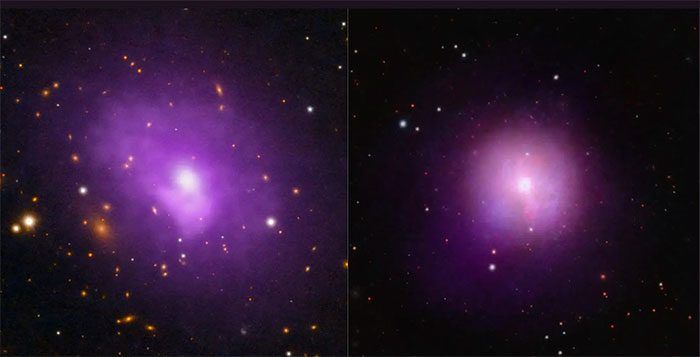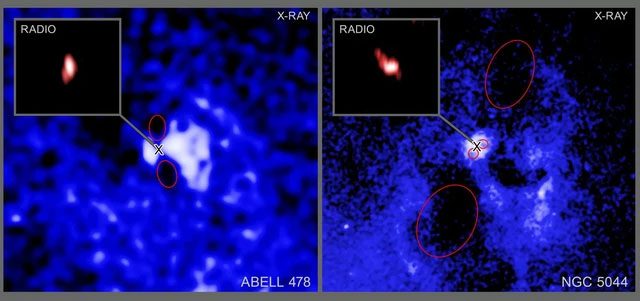A team of astronomers has investigated the pathways of powerful jets emitted by these 10 billion-year-old black holes.
According to NASA’s news site, using the Chandra X-ray Observatory, the National Radio Astronomy Observatory (NRAO) from the U.S. National Science Foundation (NSF), and the Very Long Baseline Array (VLBA), an international group of scientists has observed 16 actively raging black holes.
These are all supermassive black holes located at the centers of galaxies.

Abell 478 and NGC 5044, home to two supermassive black holes continuously “changing course” – (Image: NASA).
Unlike the dormant monster Sagittarius A* of the Milky Way galaxy, which contains Earth, these 16 black holes are actively consuming matter and ejecting tremendous streams of material into space.
In a recent study, the research team from the U.S. and Italy, led by Dr. Francesco Ubertosi from the University of Bologna, discovered that these black holes are also continuously changing direction.
Publishing their results in the scientific journal The Astrophysical Journal, the authors cite examples of two black holes located in the Abell 478 galaxy cluster and the NGC 5044 group of galaxies.

Two black holes within Abell 478 and NGC 5044 (marked with X) and the large cavities they have carved into the surrounding space due to the power of their jets (highlighted in red) – (Image: NASA).
Comparing images from Chandra and VLBA shows that the jets from the black hole in Abell 478 change direction by about 35 degrees, while the jets from the black hole in NGC 5044 change direction by approximately 70 degrees.
In total, about one-third of the observed black holes exhibited noticeable direction changes.
Some have even altered their direction by nearly 90 degrees in just 1 million to several tens of millions of years. Given that these black holes are approximately 10 billion years old, this change in direction is relatively rapid.
The jets emitted by the black holes into space are actually the result of “burps” from their intense meals, typically oriented perpendicular to the plane of the black hole.
The observed directional changes suggest that the black holes themselves may have undergone transformations, thereby altering the angles at which these furious jets are blasted into the universe.
Despite their power and intimidation, these jets are ultimately not deadly.
In fact, they inject significant energy into the inner and central regions of the galaxy, causing the hot gas within the galaxy to continuously be heated and preventing it from cooling down.
However, this process stimulates star formation and contributes to the growth of the galaxy.
Conversely, if a black hole changes direction too drastically, the area it previously bombarded will no longer be heated as before, thereby slowing down the star formation process.
This discovery sheds light on how central black holes influence the life of the galaxies they inhabit, as well as the surrounding space and potentially even neighboring galaxies within the same cluster.



















































